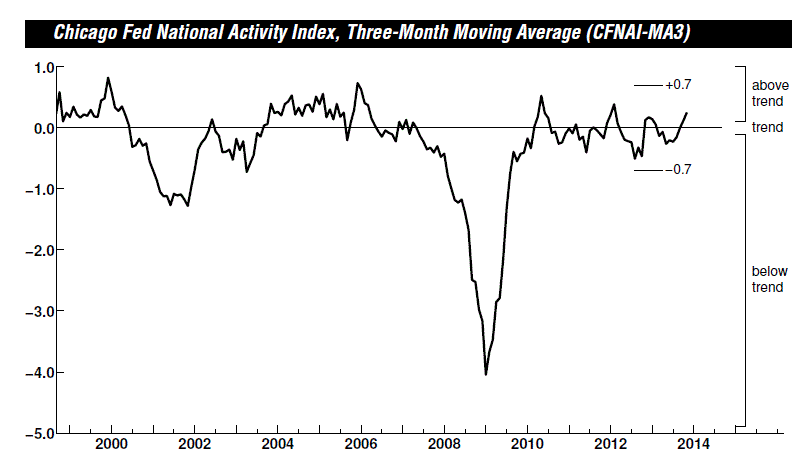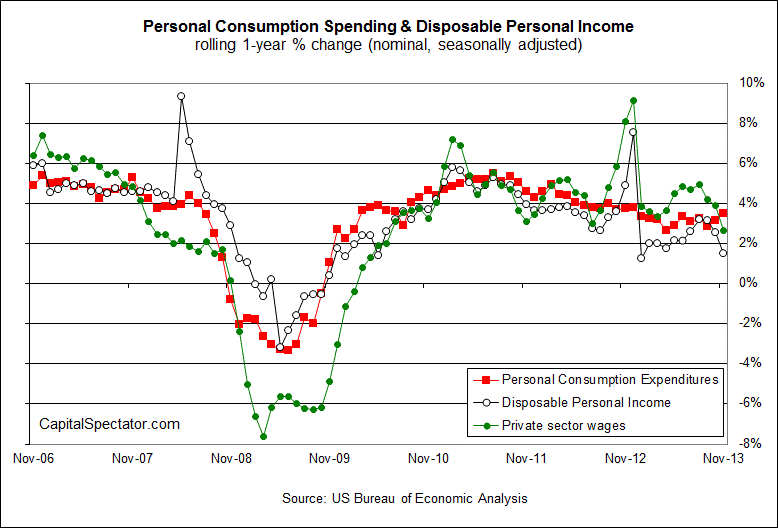Yesterday’s updates on personal income and spending, along with the latest estimate of the Chicago Fed National Activity Index, offer some holiday cheer—for the most part. But while consumer spending and economic activity overall posted healthy gains last month, the income side of the ledger looks increasingly wobbly.
First, the good news. The big-picture trend for the US economy continues to look encouraging. The three-month average of the Chicago Fed National Activity Index rose to +0.25 in November—the highest since February 2012. As a result, US economic growth is running at its strongest pace in nearly two years.
Consumer spending was also bubbly in November. Personal consumption expenditures (PCE) increased 0.5% last month over October, the best monthly comparison since June and the seventh straight month of higher spending.
"Jobs are growing, confidence is growing, households and asset values are climbing," notes Paul Edelstein, director of financial economics at IHS. "There appears to be some sort of gathering momentum in the economy."
So it's all peaches and cream? Not quite. There's always something to worry about and the sluggish trend in income growth is at the top of the list these days. Disposable personal income (DPI) increased a light 0.1% in November, which falls short of making up the lost ground in October’s 0.2% decline.
Monthly data is noisy and so it’s best to focus on the year-over-year comparisons for a clearer look at the trend. Unfortunately, the numbers for income don’t look encouraging on this front either. DPI’s annual change continues to slump, rising only 1.5% last month vs. a year ago. That’s a sharp deceleration from October’s 2.6% year-over-year rate. It’s also the second-slowest pace of growth this year. 
If income growth continues to slow (or perhaps turn negative in the near future?), that will be a dark sign for consumer spending. For the moment, the two indicators are moving in opposite directions, but the divergence will soon be corrected. The only question: will spending slow or income rise?
The outcome will be favorable if the labor market continues to post improving numbers, as it has in recent months. More jobs, after all, translate into more income. Recent updates have brought modestly better news. The three-month average gain for private payrolls, for instance, has been running at 190,000-plus through October and November. That’s higher than the sluggish 158,000-to-167,000-three-month range during the July-through-September period.
The question is whether this lagging data will soon give way to the darker clouds implied by this month’s worrisome trend in initial jobless claims? New filings for unemployment benefits have surged recently: reaching the highest level since March for the week through December 14. Is this leading indicator dropping bearish clues for 2014? It’s too soon to say. Indeed, claims data is notoriously volatile in the short term. But in the wake of yesterday’s deceleration in personal income, we can’t dismiss the potential, however remote at this stage, that the labor market may hit a new round of turbulence in the months to come. We’ll know more after Thursday’s update on jobless claims. The crowd's expecting some good news: the consensus forecast sees claims dropping by more than a trivial degree, according to Briefing.com.
Meantime, consumers are spending more and economic growth has strengthened. The slowdown in income, however, looks like a speed bump. Perhaps Thursday's jobless claims data will tell us if we should (or shouldn't) worry.
